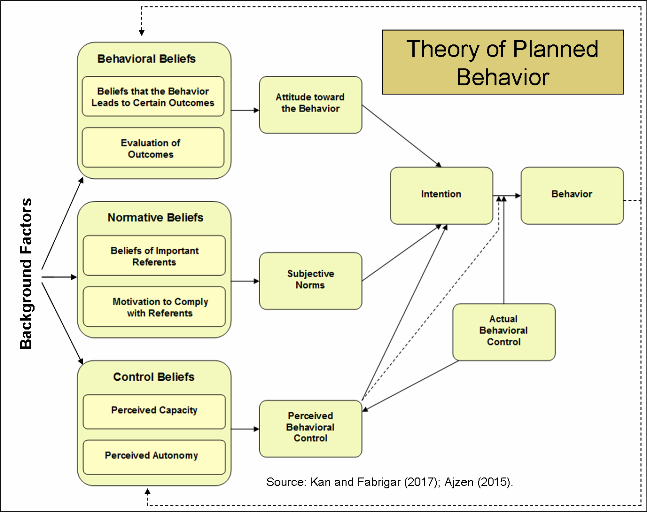First the chart, then a brief explanation.
Behavioral Beliefs
Beliefs that the Behavior Leads to Certain Outcomes: A person's subjective probability that performing a certain behavior will lead to a particular outcome or experience, for example, that exercising more will improve one’s health or be boring.
Evaluation of Outcomes: Positive evaluations refer to the beliefs about the effectiveness of the proposed behavior in achieve a desired outcome. Negative evaluations refers to beliefs about the behavior’s adverse consequences.
Normative Beliefs
Beliefs of Important Referents: Whether a given individual or group (e.g., friends, family, spouse, coworkers, one's physician or supervisor) approves or disapproves of a certain behavior and whether they would perform the behavior themselves.
Motivation to Comply with Referents: The extent to which one is motivated to comply with the opinions and behaviors of important others.
Control Beliefs
Perceived Capacity: The belief that one is capable of performing the behavior.
Perceived Autonomy: The belief that the decision to perform the behavior is under one’s control.
Attitude toward the Behavior: Positive or negative, based on beliefs regarding the likely consequences of the behavior
Subjective Norms: Based on accessible Normative Beliefs, which contribute to the overall perceived social pressure to engage in the behavior of interest.
Perceived Behavioral Control: The perceived degree of control over the behavior of interest. Same as self-efficacy. Often used as a proxy for Actual Behavioral Control, which can be hard to measure.
Intention: Attitude, subjective norms, and perceived behavioral control produce a disposition to perform the behavior of interest.
Actual Behavioral Control: Unanticipated events, insufficient time, lack of requisite skills and a multitude of other factors may prevent one from acting as intended. Actual control over a behavior depends on the ability to overcome barriers of this kind and on the presence of facilitating factors, such as assistance provided by others. Actual behavioral control feeds back to perceived control.
Background Factors: Factors that influence intention and behavior indirectly through their effect on behavioral, normative, and/or control beliefs. Examples include health, temperament, education, social status, group identity and culture.
Dotted arrow from Behavior back to Beliefs: Performance of a behavior provides real-world information (e.g., actual outcomes and barriers) that will likely “change some of the behavioral, normative, and control beliefs and thus influence future intentions regarding the behavior in question.” (Ajzen, 2020)
Note: The theory of planned behavior requires beliefs to be accessible for them to influence intention and behavior. However, this does not mean that behavior is necessarily a highly deliberative act, with each step mulled over, articulated, and endorsed before proceeding to the next step. The brain can choose, plan and produce behaviors rather quickly.
—
References:
Ajzen, I. (2015). Consumer attitudes and behavior: The theory of planned behavior applied to food consumption decisions. Rivista di Economia Agraria 70: 121-138.
Ajzen, I. The theory of planned behavior: Frequently asked questions. Hum Behav & Emerg Tech. 2020; 2: 314– 324. https://doi.org/10.1002/hbe2.195
Kan M.P.H., Fabrigar L.R. (2017) Theory of Planned Behavior. In: Zeigler-Hill V., Shackelford T. (eds) Encyclopedia of Personality and Individual Differences. Springer, Cham. https://doi.org/10.1007/978-3-319-28099-8_1191-1
Reasoned action approach https://www.wikiwand.com/en/Reasoned_action_approach
